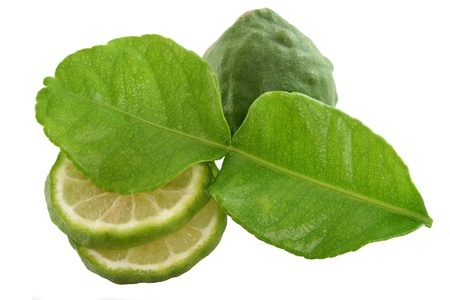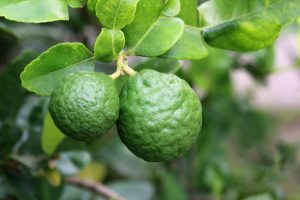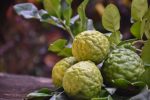
Kaffir Lime leaves are quite a speciality in Thai and Indonesian cuisine but they are now used in mainstream cooking. The Lime (Citrus hystrix DC.) has seen some interesting research into its health and medical properties although this is in its early stages. The fruit belongs to the Rutaceae family. For many centuries this lime was considered inferior to other limes until the unique flavour of the oils from its leaves and the zest propelled it into the cuisine of Asia.
The leaves belong to a citrus fruit which has highly distinctive aroma and imparts a wonderful zestiness to cooking. The volatile oils (the essential oils) are important in various cosmetics, especially perfumery have also been used to treat acne and disrupt bacterial growth. Virtually all parts of the plant are aromatic and for many it is the leaves which have the most value.
We also know it as limau purut, the Mauritius Papeda or Makrut Lime. Because Kaffir is a derogatory term, you will find references to it in the literature as k-lime, Keiffer lime and Thai lime too. A range of names are listed in Lim’s book “Edible Medicinal And Non-Medicinal Plants” (Lim, 2012).
The fruit is dark green when young, and round and about the same size as a western lime which is 2 inches on average. It has a distinct nipple on the stem end. The rind is thick, wrinkled, lumpy and knobbly. Some people also call it the porcupine orange too because of its appearance. With age, the fruit fades to a light, yellow-green. The fruit is borne on a thorny bush rather than a tree.
The zest from the rind is often used in cooking especially for curry pastes. The flavour is bitter and tart, and ideal for sweet and savoury sauces and pickles as a result. It is not especially juicy so has never been commercially used in that type of industry. For some, the bitterness makes it unpalatable until it is processed.
Areas grown: Tropical Asia. It is an important commercial crop in Thailand, Malaysia, Indonesia and Philippines. It grows to some extent in European climates.
The Malaysians believe that the fruit wards off evil spirits. For the Chinese, it is added to bath water for bathing at the start of the new lunar year. The limes are used in Indonesia to treat mouth ulcers and protect the teeth from decay.
The leaves are purchased regularly but the fruit is not so easy to find. The best approach is to grow the tree. The leaves: mostly purchased dried from general food retailers and specialist wholesalers.
Volatile Composition
As with many other citrus fruits such as lemon and calamondin, the molecule imparting the key aroma is (-)-(S)-citronellal. The volatile is also a key component in Lemon Balm essential oil. Most lime leaf oil contains a maximum of 80% w/w whilst the remainder is made up of citronellol (12%), nerol and limonene.
The lime fruit peel which I’ve used in some cuisine also contains limonene and β-pinene. The methanolic extract of this ingredient apparently can suppress hydroxyl radical formation (Khuwijitjaru et al., 2008).
An ethyl ethanoate extract from the peel has good antimicrobial activity against a range of Gram-positive bacteria and a few molds such as Staphylococcus aureus, Listeria monocytogenes, Bacillus cereus, Saccharomyces cerevisiae var. Saki and Aspergillus fumigatus (Chanthapon et al., 2008). The key antibacterials include carvacrol, geraniol, perillaldehyde and thymol. One major study has looked at inhibition of Bacillus cereus specifically in cooked rice. It’s worth noting that this bacteria is particularly noxious when rice is left uncovered for more than two hours where it can grow effectively (Jaisai and Lamlertthon, 2007).
The leaf also contains a wide range of flavonoids, terpenoids, tannins, saponins and alkaloids.
Medicinal Properties
Early days yet on the medical benefits of the leaf components. The traditional uses are many and varied and we review a few here.
Cancer Benefits
Studies on cancer cell lines indicate that there are two glyceroglycolipids which have some activity against the activiation of Epstein-Barr virus which is capable of generating tumours. It is thought that inhibition of the arachidonic acid cascade may be at the heart of the inhibitory effects where leukemia is concerned (Chueahongthomng et al., 2011 and references contained within). Extracts are also active against cervical cancer and neuroblastoma cells (Tunjung et al., 2015, 2016).
Improvements In Oral Health
Kaffir lime has traditionally been used to help improve oral health. One approach has been to rub the leaves directly around the gums which stops bacterial growth. An extract of the leaf is claimed to inhibit biofilm formation of Streptococcus mutans which is attributed to blocking this bacteria’s adhesion to teeth and to various genetic factors. This bacteria is associated with plaque formation and gingivitis (Kooltheat et al., 2016). The essential oil too is mixed into mouthwash and toothpastes to achieve a similar effect (Srisukh et al., 2006).
The fruit clearly is not used in this regard because of the high acidity of the pulp.
Looking After Your Skin
Kaffir lime extracts along with the juice are commonly added to cosmetic and bath products because of the sweet citrus aroma. The extracts also have antioxidant benefits which neutralise free radicals produced by reactions. The bioactive components in essential oils are generally effective in this regard so there is nothing particularly unique about the properties of kaffir lime essential oil save that it is particularly useful in acne management (Lertsatitthanakorn et al., 2006).

Products
This item contains links to an affiliate marketing partner. Please read our affiliate disclosure.
Purchase your kaffir limes here
References

Leave a Reply